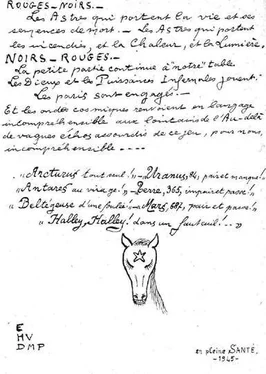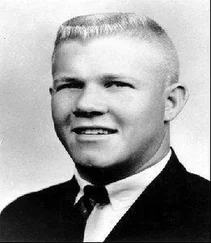All this work as a Resistant, Petiot said, led to his arrest, imprisonment, and torture by the Gestapo. Then, after his release, Petiot realized that he was under close surveillance by the Gestapo, and still shaken by his prison ordeal, he retreated to Auxerre to recuperate. He returned to rue Le Sueur for the first time in early February 1944. It was then that he discovered that his building had been filled with bodies.
AFTER this unofficial interrogation, Captain Simonin handed Petiot over to the Police Judiciaire. The following day, Simonin would himself be brought before an official purge tribunal that examined cases of suspected collaboration. It was a five-minute hearing. Receiving a guilty verdict, Simonin was ousted from his position in intelligence. He disappeared. Years later, when he reemerged, he was convinced that his punishment had emanated from a certain faction that sought revenge for his arrest of Marcel Petiot.
Petiot, in the meantime, was met at the Police Judiciaire by Lucien Pinault, Commissaire Massu’s successor, and Ferdinand Gollety, the juge d’instruction , the examining magistrate, who, in French law, conducts pretrial questioning, summons the witnesses, and compiles the dossier. Then, if he finds sufficient reason, the juge d’instruction forwards the evidence to the public prosecutor to draw up the indictment. Gollety, a short man from Boulogne-sur-Mer, on the northern coast, was regarded as a rational, no-nonsense magistrate with a scrupulous regard for detail. He was also a thirty-two-year-old official in his first posting.
The defendant was, at this point, required only to declare his identity, not make a statement. Petiot made one anyway:
My conscience does not reproach me in the least. I am proud of what I did as a patriot. If I have not obeyed all civil laws, I have obeyed the laws of war. Otherwise, the occupation imposed certain precautions on me. Among my comrades in combat, fifty knew my true identity. It required only one of fifty to denounce me, and one did
.
Petiot also retained as his legal counsel a rising star in the world of criminal defense, the forty-one-year-old Sorbonne-trained Maître René Edmond Floriot. “A demon for detail,” Floriot had already defended Petiot in the two narcotics cases of 1942. Petiot had first seen Floriot’s talents firsthand in 1937, when the attorney successfully defended one of his patients, Magda Fontages, for attempted murder of the French ambassador to Italy, Count Charles de Chambrun. Fontages was also known for seducing many powerful men, including Benito Mussolini, who at the height of passion liked to rip off her black silk scarf and pretend to strangle her.
Pretrial questioning would be an elaborate process that would ultimately last fourteen months. It would not begin for another thirty-six hours, however, as it was already late in the evening of the 31st and November 1 was a public holiday. Petiot was taken to cell 7 of Sector 7 of Prison de la Santé, a large gray building constructed in 1867 in the 14th arrondissement. Petiot would join many suspected collaborators, Gestapo agents, black market profiteers, and other people who were accused of benefiting from the German Occupation. Petiot’s sector was reserved for prisoners on death row.
“I have been a member of the Resistance since the Germans first arrived in Paris,” Petiot said in his first official interrogation on November 2, 1944. He would repeat many of the claims he had made to Captain Simonin, but also add a few details. He had issued false certificates of disability to help Frenchmen avoid deportation to Germany and other requisitions or demands from Occupation authorities. He told of using his secret weapon twice, fatally wounding a German motorcyclist on rue Saint-Honoré and another soldier on rue La Fayette. He said that the Americans had declined to adopt his invention, and that was a mistake. “A five-ton truck,” Petiot said, “could have carried enough of the gadgets to liquidate the million Germans trampling France under their jackboots.”
Petiot refused to provide more detail about this supposedly deadly weapon. There was still too much uncertainty, he argued, and the Germans might return at any time and use it against his country. However unlikely this may have sounded, this belief was actually common in some circles, particularly in rural southern France. Many people feared that former collaborators were hiding in the countryside and planning to sabotage the Liberation with hopes of installing another German-friendly authoritarian regime. When a handful of former collaborators were uncovered in December 1944 after in fact secretly returning to France, probably as part of the Nazi Ardennes offensive, the unlikely rumor would gain more credence.
Then, in his blunt fashion, Petiot gave another reason for his reticence to describe his invention: His interrogators were “too uncultivated in scientific matters to be able to understand.”
When Gollety mentioned that Petiot would be well advised to reconsider, given that he was likely facing twenty-four counts of murder, Petiot countered unexpectedly that the juge d’instruction was ill-informed. He had killed sixty-three people. But these, he emphasized, were not the bodies at his house. The people he killed had been buried in the forest.
Upon his release from prison, Petiot explained to Gollety, he had been eager to avenge himself. He tried to contact his colleagues in Fly-Tox, but the organization had been vanquished, and its members who had not been imprisoned or executed had fled. It was difficult to reconnect with any of his remaining comrades because everyone used code names and they had all been changed. At the same time, Petiot had hesitated in finding his colleagues because he knew that the Gestapo often released prisoners in order to track their activities. He was certain that he was being watched and followed, and he did not want to put his fellow Resistants in harm’s way.
Petiot also related how, since being tortured by the Gestapo, he had suffered terrible headaches and increased bouts of anxiety. He felt sick upon his release from prison and needed to relax. In the end, he decided to visit his brother in Auxerre. He only returned to his apartment in Paris on or around February 8, 1944. What he found had immensely disturbed him.
Not only had the Germans stolen much of his medical equipment, including an ultraviolet machine, an infrared machine, and many other items that he had hoped to use in his clinic after the war, but Petiot found the house itself “in a great disorder, furniture knocked over or broken, cupboards disemboweled.” The old manure pit, which he had sealed long before to keep out the rats, had been uncovered and filled with various missing items from his property, including tools, smaller instruments, a portable electrical heater, and two large cushions from the waiting room. Also in the pit were a number of corpses.
“The bodies were fresh,” Petiot said, suggesting that they were put into the pit while he was in jail. The skin was still red and the heads were heavy, indicating that the brain had not yet disappeared, and this, Petiot explained, happened “very quickly during putrefaction.” The stench in the courtyard, the pile of bodies, and the bones in the basement—“I was absolutely bewildered and panic-stricken,” Petiot said.
He first believed that the bodies had been concealed there by members of Fly-Tox who must have panicked. Later, after contacting a few members in secret, he said, he changed his opinion. It was the Germans who had dumped the bodies on his property. Petiot never explained how he would have connected with his fellow Resistants when, as he had just said, the surviving members had all changed names and he had not tried to find them for fear of exposing them to the Gestapo.
Читать дальше












